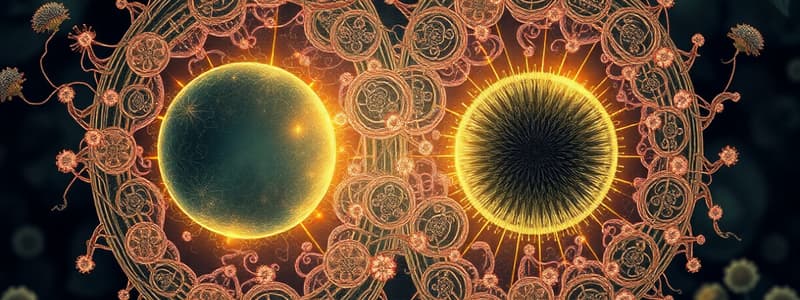Podcast
Questions and Answers
What occurs during the Gap 2 phase of the cell cycle?
What occurs during the Gap 2 phase of the cell cycle?
- DNA replication occurs.
- Chromosomes condense into chromatin.
- The cell grows and produces new proteins. (correct)
- Cytokinesis takes place.
What marks the end of prophase in mitosis?
What marks the end of prophase in mitosis?
- Chromatin condensing into visible chromosomes. (correct)
- The separation of chromatids.
- Spindle fibers aligning the chromosomes.
- The formation of the nuclear membrane.
Which statement about anaphase is accurate?
Which statement about anaphase is accurate?
- The nucleolus reappears.
- Chromosomes are pulled towards opposite ends of the cell. (correct)
- Centrioles move towards the nucleus.
- Chromatids align along the metaphase plate.
What distinguishes cytokinesis in animal cells from that in plant cells?
What distinguishes cytokinesis in animal cells from that in plant cells?
During which phase do chromosomes become attached to spindle fibers?
During which phase do chromosomes become attached to spindle fibers?
What occurs during anaphase I of meiosis?
What occurs during anaphase I of meiosis?
What distinguishes metaphase II from metaphase I in meiosis?
What distinguishes metaphase II from metaphase I in meiosis?
What is the result of cytokinesis following telophase I in meiosis?
What is the result of cytokinesis following telophase I in meiosis?
What happens to the chromosomes after telophase I in rapid meiosis?
What happens to the chromosomes after telophase I in rapid meiosis?
Which statement about prophase II is correct?
Which statement about prophase II is correct?
Flashcards
G2 Checkpoint
G2 Checkpoint
A control point in the cell cycle, checking if the cell can proceed to mitosis after DNA synthesis.
Prophase (Mitosis)
Prophase (Mitosis)
First stage of mitosis where chromosomes condense and spindle fibers form.
Metaphase (Mitosis)
Metaphase (Mitosis)
Stage where chromosomes line up in the middle of the cell.
Anaphase (Mitosis)
Anaphase (Mitosis)
Signup and view all the flashcards
Cytokinesis (Mitosis)
Cytokinesis (Mitosis)
Signup and view all the flashcards
Anaphase I in Meiosis
Anaphase I in Meiosis
Signup and view all the flashcards
Meiosis I vs Mitosis
Meiosis I vs Mitosis
Signup and view all the flashcards
Telophase I in Meiosis
Telophase I in Meiosis
Signup and view all the flashcards
Meiosis II
Meiosis II
Signup and view all the flashcards
Prophase II in Meiosis
Prophase II in Meiosis
Signup and view all the flashcards
Study Notes
Cell Division Overview
- Two main types of cell division: mitosis and meiosis
- Mitosis: division of somatic (body) cells
- Meiosis: division of gametes (sex cells)
Mitosis
- Mitosis is nuclear division plus cytokinesis
- Results in two identical daughter cells
- Stages include prophase, prometaphase, metaphase, anaphase, and telophase
- Interphase is not part of mitosis, but encompasses G1, S, and G2 of the cell cycle
Phases of Mitosis
- Interphase: Cell grows, replicates its chromosomes, and prepares for division
- Contains G1 (cell growth), S (DNA synthesis), and G2 (cell growth) phases
- Chromosomes are not clearly visible
- Nucleolus is visible
- Centrioles (or microtubule organizing centers in plants) are present.
- Prophase: Chromatin condenses, becomes visible chromosomes. Nucleolus disappears
- Chromosomes thicken, shorten and become paired.
- Two chromatids joined by a centromere
- Centrioles move to opposite ends of cells and fibers extend from centromeres
- Some fibers form the mitotic spindle.
- Metaphase: Spindle fibers align chromosomes along middle of cell nucleus (metaphase plate)
- Chromosomes are thick and coiled
- Spindle fibers connect to chromosomes via centromeres
- Homologous chromosomes do not associate
- Anaphase: Paired chromosomes separate at kinetochores and move to opposite sides of the cell
- Spindle fibers separate sister chromatids
- Chromosome movement results from a combination of interactions.
- Telophase: Chromatids arrive at opposite poles
- New membranes form around nuclei
- Chromosomes disperse and are no longer visible in light microscope
- Spindle fibers disperse
- Cytokinesis may begin
Cytokinesis
- Process of dividing the cytoplasm
- In animal cells: actin fiber ring contracts, pinching cell into two
- In plant cells: cell plate synthesized between two daughter cells
Meiosis
- Produces haploid gametes
- Reduces chromosome number by half
- Occurs only in special cells
- Results in four haploid daughter cells
- Consists of Meiosis I and Meiosis II (each with similar stages to mitosis phases such as Prophase I, Metaphase I, and Telophase I, also Prophase II, Metaphase II, and Telophase II).
Meiosis I
- Prophase I: Duplicated chromosomes pair, cross over, and become visible
- Metaphase I: Paired homologous chromosomes align on a plane equidistant from the poles (metaphase plate)
- Anaphase I: Homologous chromosomes separate and move to opposite poles (sister chromatids remain attached)
- Telophase I: Homologous chromosome pairs complete migration, forming two haploid sets at opposite poles, followed by cytokinesis
Meiosis II
- Interphase (before Meiosis II): No chromosome replication takes place
- Prophase II: Spindle forms; the nuclear envelope breaks down
- Metaphase II: Chromosomes align on the metaphase plate
- Anaphase II: Sister chromatids separate, becoming chromosomes
- Telophase II: Chromosomes complete migration and cytokinesis results in forming four haploid daughter cells
Studying That Suits You
Use AI to generate personalized quizzes and flashcards to suit your learning preferences.




